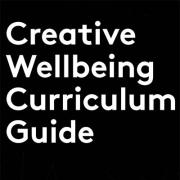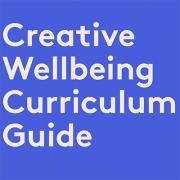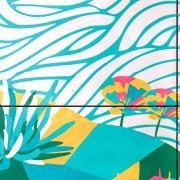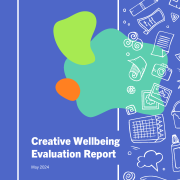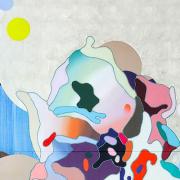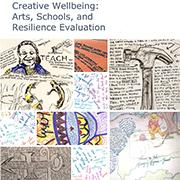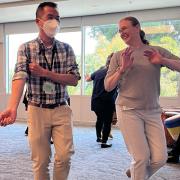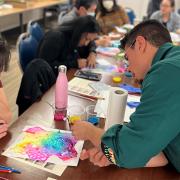"Canopy of Blossoms" by Suzy Taekyung Kim.
Creative Wellbeing is an approach for fostering communities of wellness that was developed collaboratively by the LA County Department of Arts and Culture, Office of Child Protection (OCP), Department of Mental Health (DMH), and Arts for Healing and Justice Network (AHJN).
The Creative Wellbeing approach uses arts-based strategies that build upon existing community strengths to enhance the capacity of adults to support young people in restoration and healing. Central to this model for supporting youth is a parallel process that supports the adults who work with them—strengthening protective factors by increasing adults’ understanding of healing-informed approaches, self-attunement, and the preventative significance of their own self-care. As young people engage in healing-informed arts education, they explore identity and self-expression, discover ways to connect, and access an authentic sense of mattering, ultimately leading to an enhanced sense of wellbeing. Taken together, these strategies strengthen supports to enhance wellbeing for youth and adults.
Creative Wellbeing offers a menu of services that include arts instruction for youth; facilitated self-care sessions for adults; and professional development for educators, staff and community-based organizations who work with systems-impacted youth. The Creative Wellbeing curriculum supports positive youth development and social-emotional learning competencies, and incorporates AHJN’s Shared Theory of Practice, which translates the experience of its member-organizations into a shared healing-informed approach to arts and cultural engagement. This culturally relevant, healing-centered, and arts-based programming led by racially and culturally diverse teaching artists creates pathways for people to connect the dots between race, culture, health, equity, and inclusion.
Creative Wellbeing Curriculum Guide
Research shows that, as of 2007, more than two-thirds of children have witnessed at least one traumatic event by the age of 16. Understanding and addressing the negative effects of trauma in youth is critical for mitigating mental health challenges. Over the past few decades, arts-based prevention, advocacy, and treatment have increasingly served to foster healing and wellbeing for individuals who have experienced trauma. Research suggests creative arts interventions are effective at enhancing psychological wellbeing by decreasing negative emotional states and enhancing positive ones. The act of engaging in the creation of art has proven to be beneficial to one’s health, productivity, and sense of empowerment. For young people, engaging in arts education activities has been shown to increase academic achievement and reduce justice system involvement and adjudication.
By combining the arts and mental health prevention efforts, Creative Wellbeing works to destigmatize mental health symptoms, uplift practices of offering and receiving support, and nurture communities of wellbeing. This project reinforces schools’ existing PBIS (Positive Behavioral Interventions & Supports) and MTSS (Multiple-Tiered Systems of Support), and extends resources to foster youth and mental health staff.
Resources & EVALUATION
Join virtual quarterly gatherings and engage through our virtual hub for ongoing asynchronous networking
In its second evaluation of the Creative Wellbeing approach, Harder+Company Community Research found that young people who participated experienced positive social-emotional benefits while also exploring their interests, building technical art skills, and increasing their access to the arts
Explore resources related to Creative Wellbeing work, including the Creative Wellbeing Curriculum Guide, released June 2022
An evaluation of the initial implementation of Creative Wellbeing was conducted by Harder+Company Community Research. The evaluation findings are published in final report that was completed in November 2020.
These end-of-year reports summarize data and learnings from surveys completed by young people and adults after participating in Creative Wellbeing arts based activities, workshops, or professional development sessions.
These end-of-year reports summarize data and learnings from surveys completed by young people and adults after participating in Creative Wellbeing arts based activities, workshops, or professional development sessions.
Questions?
If you have any questions, or to learn more please contact: Elisabeth Nails, Program Specialist, Los Angeles County Department of Arts and Culture | Enails@arts.lacounty.gov

